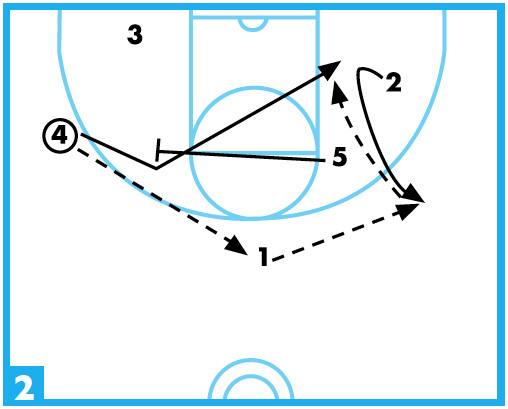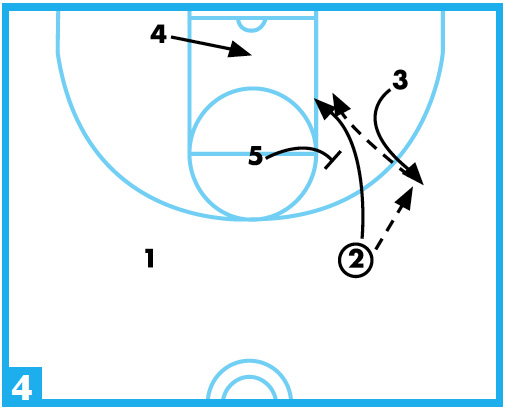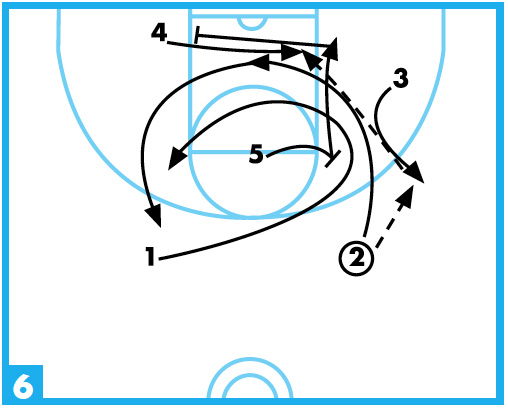The shuffle offense: An equal opportunity system
 The shuffle offense is the type of system that features a great deal of continuity with excellent floor balance. It has a certain amount of structure while allowing for individual player creativity. When run properly, each player within the offense has an equal opportunity to score.
The shuffle offense is the type of system that features a great deal of continuity with excellent floor balance. It has a certain amount of structure while allowing for individual player creativity. When run properly, each player within the offense has an equal opportunity to score.
This offense tears apart defenses from the outside, midrange and even close range. While a talented post player makes any offense stronger, it’s not a necessity for the shuffle offense.
Due to the amount of lateral movement, defenders are forced to turn their backs to the ball while repositioning themselves. This makes them vulnerable to the shuffle offense’s attack. Also, this is an offense that’s effective when run from either side of the court. So, if you end up passing the ball around the perimeter without making a move to score, the offense resets easily.
 After defending the basic set of the shuffle offense, your opponent will be confused when you incorporate individual player movements within the framework of the basic set. And, if you need a semi-delay offense, the shuffle offense works because passing around the perimeter can be used to slow the tempo.
After defending the basic set of the shuffle offense, your opponent will be confused when you incorporate individual player movements within the framework of the basic set. And, if you need a semi-delay offense, the shuffle offense works because passing around the perimeter can be used to slow the tempo.
Running the shuffle offense
DIAGRAM 1: Basic set (A). The offense can start on either side of the floor. In this instance, 2, on the right side, begins with the ball.
3, who is on the ball-side and positioned between the 3-point arc and the post, pops to the wing and receives a pass from 2. 2 then cuts to the corner. 1, who started on the weak-side position opposite 2, cuts to the top.
 3 passes to 1. On the pass, 5 sets a screen for 3. 3 uses the screen to move into the lane and cut to the opposite block. 4, who started in the short corner on the weak side, pops to the corner. 1 passes to 4. 4 fires a pass to 3 in the post.
3 passes to 1. On the pass, 5 sets a screen for 3. 3 uses the screen to move into the lane and cut to the opposite block. 4, who started in the short corner on the weak side, pops to the corner. 1 passes to 4. 4 fires a pass to 3 in the post.
DIAGRAM 2: Basic set (B). If a pass inside to 3 isn’t available, 4 begins ball reversal by passing to 1 at the top. 2 curls to the wing and receives a pass from 1.
5 comes across the formation to set a screen for 4. 4 uses the screen to cut through the lane toward the opposite post. If open, 2 passes to 4.
 This shows how the offense may start on one side of the court but, due to the defense, has to use ball reversals to keep the offense moving and effective.
This shows how the offense may start on one side of the court but, due to the defense, has to use ball reversals to keep the offense moving and effective.
DIAGRAM 3: Lob option. This is used to keep the defense honest after running the basic set. After 2 passes to 3 and goes to the corner, 3 immediately passes back out to 1 at the top. 3 then sets a lateral screen on 5.
» ALSO SEE: Breakdown drills for teaching the backdoor offense
5 rolls to the basket looking for a lob pass from 1. This lob pass typically results in an easy layup or short jump-shot option. Many times, this action leads to a 3-point play as the defense is out of position, rotates late, and fouls 5 on the way up.
There also is a good chance that 4’s defender leaves 4 to cover 5. 4 always cuts to the basket and looks for a possible pass from 5.
 DIAGRAM 4: Give-and-go option. This is another option off the basic movement to create defensive confusion. 2 passes to 3 as normal, then immediately cuts off of a screen from 5. 2’s cut is straight to the basket. 3 hits 2 with a pass in stride for an easy layup.
DIAGRAM 4: Give-and-go option. This is another option off the basic movement to create defensive confusion. 2 passes to 3 as normal, then immediately cuts off of a screen from 5. 2’s cut is straight to the basket. 3 hits 2 with a pass in stride for an easy layup.
Adding this cut to the shuffle set again keeps the defense honest. The defender now is not sure if 2 is going to cut to the corner (as in the basic movement) or straight to the basket. Making 2 a scoring threat forces defenders to play him or her straight instead of cheating toward the corner.
2 also has the option to pass back to 3 for a long-range shot or pass to 4, who has cut toward the basket. 4 needs to cut to the hoop, regardless of whether 2 has the ability to make a pass, as 4 needs to serve as the weak-side rebounder on a missed shot.
 DIAGRAM 5: Circle movement. There are times when running 2 off of 5’s pick doesn’t allow for a pass back to 2. In this case, 2 rolls back to the top of the set by going through the lane, then circling from the backside of the offense. As 2 clears through the initial cut, 1 follows 2 and cuts off of 5’s screen. 1 now looks for the pass from 3.
DIAGRAM 5: Circle movement. There are times when running 2 off of 5’s pick doesn’t allow for a pass back to 2. In this case, 2 rolls back to the top of the set by going through the lane, then circling from the backside of the offense. As 2 clears through the initial cut, 1 follows 2 and cuts off of 5’s screen. 1 now looks for the pass from 3.
This creates another problem for the defense, because the continual movement and additional cutting to the inside forces them to defend a different player cutting to the interior. Plus, by this point, the defense likely is chasing 1 from behind. That puts them in a difficult position to stop what you’re doing.
» ALSO SEE: 6 drills to improve offensive rebounding
3 should be able to pass to 2 or 1 cutting through the lane for a short shot. If neither receives a pass, they simply roll out to their original spots and the shuffle offense restarts.
 DIAGRAM 6: Additional movement. When 3 cannot send a pass to 2 or 1 cutting through the lane, 2 and 1 circle through and move to their original spots. In this instance, 5 slides down to the low post and looks for a pass from 3.
DIAGRAM 6: Additional movement. When 3 cannot send a pass to 2 or 1 cutting through the lane, 2 and 1 circle through and move to their original spots. In this instance, 5 slides down to the low post and looks for a pass from 3.
If the pass cannot be made, 5 sets a baseline screen for 4. 4 cuts across the lane along the baseline and looks for a pass from 3 for a scoring opportunity.
Semi-delay offense
Use this as a semi-delay offense whenever you believe you’re in a position to win during the late stages of a game. You want to run clock and prevent the opponent from heading to the other end of the court with the ball.
I call this situation the “perimeter shuffle.” When I tell my players we’re in this offense, they know we do not want the opponent to touch the ball for the remainder of the game.
In perimeter shuffle, simply run the offense from its basic set and principles. Send your cutters through the interior to force the defense to cover the inside scoring areas, which relieves defensive pressure on the perimeter. Also, move the ball around the perimeter to let the clock run.
Because the offense still appears to be in scoring mode, you fool the defense into thinking they’re defending your regular offense. In reality, you’re milking the clock with no intention of shooting. Of course, if a player has an open layup opportunity, have them take it. A made layup when you already have enough points to win should be icing on the cake.
Be sure to work the perimeter shuffle frequently in practice so players are accustomed to running through the motions at game speed. The last thing you want is players to relax, throw an errant or lazy pass, and watch the opponent sprint to the other end and score.
If worked regularly in practice, the perimeter shuffle should be a call you want to make in all late-game situations. That means victory is only seconds away.
Brian Vukadinovich is a retired basketball coach. He coached at North Newton High School and Ancilla College in Indiana, and was a scout for several colleges.









